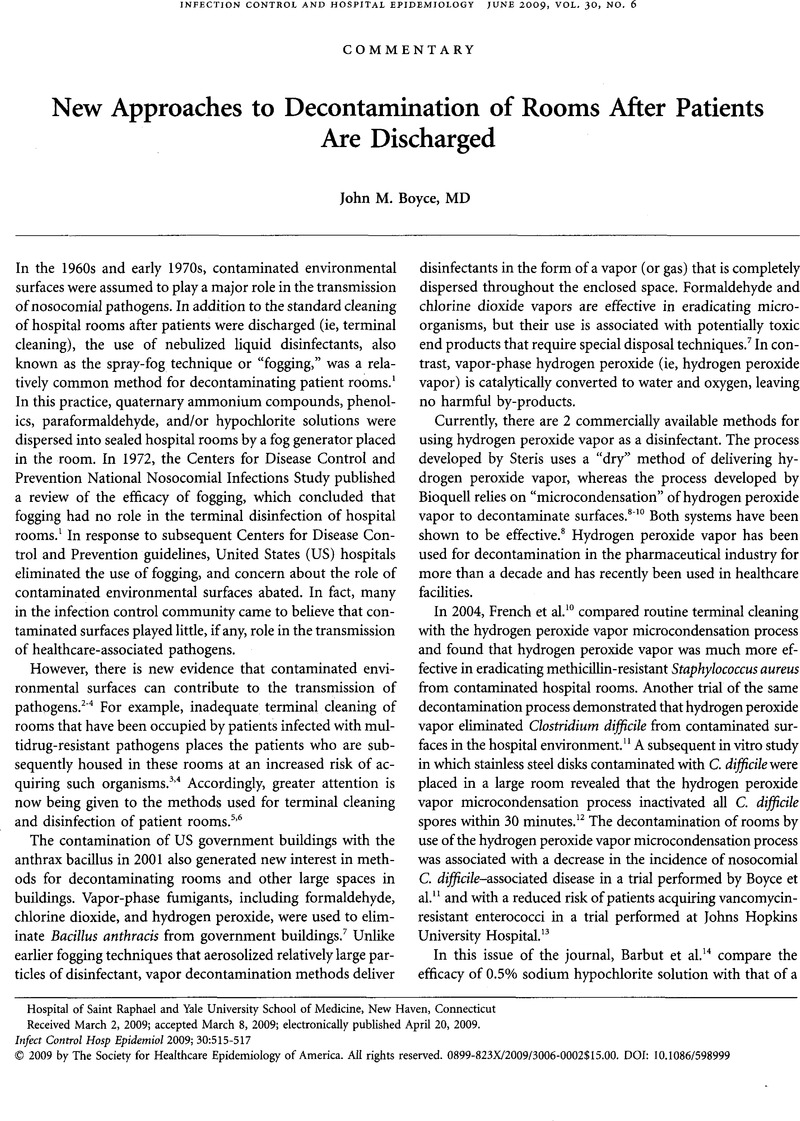Crossref Citations
This article has been cited by the following publications. This list is generated based on data provided by Crossref.
Otter, Jonathan A.
Havill, Nancy L.
and
Boyce, John M.
2010.
Hydrogen Peroxide Vapor Is Not the Same as Aerosolized Hydrogen Peroxide.
Infection Control & Hospital Epidemiology,
Vol. 31,
Issue. 11,
p.
1201.
Nerandzic, Michelle M
Cadnum, Jennifer L
Pultz, Michael J
and
Donskey, Curtis J
2010.
Evaluation of an automated ultraviolet radiation device for decontamination of Clostridium difficile and other healthcare-associated pathogens in hospital rooms.
BMC Infectious Diseases,
Vol. 10,
Issue. 1,
Otter, Jonathan A.
and
Yezli, Saber
2010.
Cycle times for hydrogen peroxide vapour decontamination.
Canadian Journal of Microbiology,
Vol. 56,
Issue. 4,
p.
356.
Mallozzi, Michael
Viswanathan, VK
and
Vedantam, Gayatri
2010.
Spore-forming Bacilli and Clostridia in human disease.
Future Microbiology,
Vol. 5,
Issue. 7,
p.
1109.
Rutala, William A.
Gergen, Maria F.
and
Weber, David J.
2010.
Room Decontamination with UV Radiation.
Infection Control & Hospital Epidemiology,
Vol. 31,
Issue. 10,
p.
1025.
Chan, H.-T.
White, P.
Sheorey, H.
Cocks, J.
and
Waters, M.-J.
2011.
Evaluation of the biological efficacy of hydrogen peroxide vapour decontamination in wards of an Australian hospital.
Journal of Hospital Infection,
Vol. 79,
Issue. 2,
p.
125.
Jafri, Anwar Abbas
Gupta, Sanjay
Ibrahim, Zaki
Baker, Paul
Oswald, Tamsin
and
Reed, Mike R
2011.
Assessing the efficacy of photocatalytic oxidation on bacterial contamination in a clinical setting – a randomised controlled trial.
Journal of Infection Prevention,
Vol. 12,
Issue. 6,
p.
251.
Piskin, Nihal
Celebi, Guven
Kulah, Canan
Mengeloglu, Zafer
and
Yumusak, Mehtap
2011.
Activity of a dry mist-generated hydrogen peroxide disinfection system against methicillin-resistant Staphylococcus aureus and Acinetobacter baumannii.
American Journal of Infection Control,
Vol. 39,
Issue. 9,
p.
757.
Otter, Jonathan A.
Yezli, Saber
and
French, Gary L.
2011.
The Role Played by Contaminated Surfaces in the Transmission of Nosocomial Pathogens.
Infection Control & Hospital Epidemiology,
Vol. 32,
Issue. 7,
p.
687.
Holmdahl, T.
Lanbeck, P.
Wullt, M.
and
Walder, M. H.
2011.
A Head-to-Head Comparison of Hydrogen Peroxide Vapor and Aerosol Room Decontamination Systems.
Infection Control & Hospital Epidemiology,
Vol. 32,
Issue. 9,
p.
831.
Davies, A.
Pottage, T.
Bennett, A.
and
Walker, J.
2011.
Gaseous and air decontamination technologies for Clostridium difficile in the healthcare environment.
Journal of Hospital Infection,
Vol. 77,
Issue. 3,
p.
199.
Havill, Nancy L.
Moore, Brent A.
and
Boyce, John M.
2012.
Comparison of the Microbiological Efficacy of Hydrogen Peroxide Vapor and Ultraviolet Light Processes for Room Decontamination.
Infection Control & Hospital Epidemiology,
Vol. 33,
Issue. 5,
p.
507.
Dusseau, Jean-Yves
Duroselle, Patrick
and
Freney, Jean
2012.
Russell, Hugo & Ayliffe's.
p.
306.
DeLegge, Mark H.
Andris, Deborah A.
Mirtallo, Jay M.
and
Guenter, Peggi
2012.
Parenteral Nutrition Therapy Over the Next 5–10 Years.
Journal of Parenteral and Enteral Nutrition,
Vol. 36,
Issue. 2S,
Walder, Mats
and
Holmdahl, Torsten
2012.
Reply to Roberts.
Infection Control & Hospital Epidemiology,
Vol. 33,
Issue. 3,
p.
312.
Fu, T.Y.
Gent, P.
and
Kumar, V.
2012.
Efficacy, efficiency and safety aspects of hydrogen peroxide vapour and aerosolized hydrogen peroxide room disinfection systems.
Journal of Hospital Infection,
Vol. 80,
Issue. 3,
p.
199.
Fontes, Belchor
Cattani Heimbecker, Ana Maria
de Souza Brito, Glacus
Costa, Silvia F
van der Heijden, Inneke M
Levin, Anna S
and
Rasslan, Samir
2012.
Effect of low-dose gaseous ozone on pathogenic bacteria.
BMC Infectious Diseases,
Vol. 12,
Issue. 1,
Otter, J.A.
Yezli, S.
Perl, T.M.
Barbut, F.
and
French, G.L.
2013.
The role of ‘no-touch’ automated room disinfection systems in infection prevention and control.
Journal of Hospital Infection,
Vol. 83,
Issue. 1,
p.
1.
Otter, Jonathan A.
Yezli, Saber
Salkeld, James A.G.
and
French, Gary L.
2013.
Evidence that contaminated surfaces contribute to the transmission of hospital pathogens and an overview of strategies to address contaminated surfaces in hospital settings.
American Journal of Infection Control,
Vol. 41,
Issue. 5,
p.
S6.
Nerandzic, Michelle M.
Fisher, Christopher W.
Donskey, Curtis J.
and
Setlow, Peter
2014.
Sorting through the Wealth of Options: Comparative Evaluation of Two Ultraviolet Disinfection Systems.
PLoS ONE,
Vol. 9,
Issue. 9,
p.
e107444.



